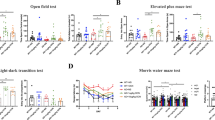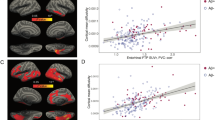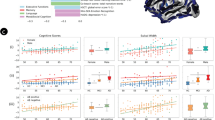Abstract
Lifestyle factors may affect mental health and play a critical role in the development of neurodegenerative diseases including Alzheimer’s disease (AD). However, whether the temperatures of daily beverages have any impact on cognitive function and AD development has never been studied. In this study, we investigated the effects of daily drinking water temperatures on cognitive function and AD development and progression in mice and the underlying mechanisms. Cognitive function of mice was assessed using passive avoidance test, open field test, and Morris water maze. Wild-type Kunming mice receiving intragastric water (IW, 10 mL/kg, 2 times/day) at 0 °C for consecutive 15 days displayed significant cognitive defects accompanied by significant decrease in gain of body weight, gastric emptying rate, pepsin activity, and an increase in the energy charge in the cortex when compared with mice receiving the same amount of IW at 25 °C (a temperature mimicking most common drinking habits in human), suggesting the altered neuroenergetics may cause cognitive decline. Similarly, in the transgenic APPwse/PS1De9 familial AD mice and their age- and gender-matched wild-type C57BL/6 mice, receiving IW at 0 °C, but not at 25 °C, for 35 days caused a significant time-dependent decrease in body weight and cognitive function, accompanied by a decreased expression of PI3K, Akt, the glutamate/GABA ratio, as well as neuropathy with significant amyloid lesion in the cortex and hippocampus. All of these changes were significantly aggravated in the APPwse/PS1De9 mice than in the control C57BL/6 mice. These data demonstrate that daily beverage at 0 °C may alter brain insulin-mediated neuroenergetics, glutamate/GABA ratio, cause cognitive decline and neuropathy, and promote AD progression.
Similar content being viewed by others
Log in or create a free account to read this content
Gain free access to this article, as well as selected content from this journal and more on nature.com
or
References
Schulz JB, Deuschl G. Influence of lifestyle on neurodegenerative diseases. Nervenarzt. 2015;86:954–9. German
Arvanitakis Z, Capuano AW, Leurgans SE, Bennett DA, Schneider JA. Relation of cerebral vessel disease to Alzheimer’s disease dementia and cognitive function in elderly people: a cross-sectional study. Lancet Neurol. 2016;5:934–43.
Bowman GL, Dayon L, Kirkland R, Wojcik J, Peyratout G, Severin IC, et al. Blood–brain barrier breakdown, neuroinflammation, and cognitive decline in older adults. Alzheimers Dement. 2018;14:1640–50.
Alzheimer’s Association. 2015 Alzheimer's disease facts and figures. Alzheimers Dement. 2015;11:332–84.
Xiao E, Xiong H, Zhao Y, Deng X, Mei Z. Study on acute toxicity and animal gastrointestinal activity of crude and processed products of Entada phaseoloides. Zhong Yao Cai. 2010;33:1704–7. Chinese
Dai Y, Ma T, Ren X, Wei J, Fu W, Ma Y, et al. Tongluo Xingnao effervescent tablet preserves mitochondrial energy metabolism and attenuates cognition deficits in APPswe/PS1De9 mice. Neurosci Lett. 2016;630:101–8.
Schmittgen TD, Livak KJ. Analyzing real-time PCR data by the comparative C T method. Nat Protoc. 2008;3:1101–8.
Fu W, Dai Y, Ma T, Wei J, Chen H, Xu S. Tongluo Xingnao effervescent tablet reverses memory deficit and reduces plaque load in APPswe/PS1dE9 mice. Exp Ther Med. 2018;15:4005–13.
Avgeropoulos N, Kelley B, Middaugh L, Arrigo S, Persidsky Y, Gendelman HE, et al. SCID mice with HIV encephalitis develop behavioral abnormalities. J Acquir Immune Defic Syndr Hum Retrovirol. 1998;18:13–20.
Bustamante C, Bilbao P, Contreras W, Martínez M, Mendoza A, Reyes A, et al. Effects of prenatal stress and exercise on dentate granule cells maturation and spatial memory in adolescent mice. Int J Dev Neurosci. 2010;28:605–9.
Zhu J, Chen X, Song Y, Zhang Y, Zhou L, Wan L. Deficit of RACK1 contributes to the spatial memory impairment via upregulating BECLIN1 to induce autophagy. Life Sci. 2016;151:115–21.
Trevisiol A, Nave KA. Brain energy metabolism: conserved functions of glycolytic glial cells. Cell Metab. 2015;22:361–3.
Tang BL. Brain activity-induced neuronal glucose uptake/glycolysis: is the lactate shuttle not required? Brain Res Bull. 2017;137:225–8.
Jha MK, Morrison BM. Glia-neuron energy metabolism in health and diseases: New insights into the role of nervous system metabolic transporters. Exp Neurol. 2018;309:23–31.
Zhang L, Tang W, Chao FL, Zhou CN, Jiang L, Zhang Y, et al. Four-month treadmill exercise prevents the decline in spatial learning and memory abilities and the loss of spinophilin-immunoreactive puncta in the hippocampus of APP/PS1 transgenic mice. Neurobiol Dis. 2020;136:104723.
Qin C, Wu S, Chen B, Wu X, Qu K, Liu J, et al. Effect of ganoderma lucidum preparation on the behavior, biochemistry and autoimmune parameters of mouse models of APP/PS1 double transgenic Alzheimer’s disease. Zhongguo Yi Xue Ke Xue Yuan Xue Bao. 2017;39:330–5.
Suckale J, Solimena M. The insulin secretory granule as a signaling hub. Trends Endocrinol Metab. 2010;21:599–609.
Collins BC, Gillet LC, Rosenberger G, Röst HL, Vichalkovski A, Gstaiger M, et al. Quantifying protein interaction dynamics by SWATH mass spectrometry: application to the 14-3-3 system. Nat Methods. 2013;10:1246–53.
Ford TC, Nibbs R, Crewther DP. Glutamate/GABA+ ratio is associated with the psychosocial domain of autistic and schizotypal traits. PLoS One. 2017;12:e0181961. https://doi.org/10.1371/journal.pone.0181961.
Schwarzinger M, Pollock BG, Osm H, Dufouil C, Rehm J, Group QDS. Contribution of alcohol use disorders to the burden of dementia in France 2008-13: a nationwide retrospective cohort study. Lancet Public Health. 2018;3:e124–32.
Spear LP. Effects of adolescent alcohol consumption on the brain and behaviour. Nat Rev Neurosci. 2018;19:197–214.
Rogers GB, Keating DJ, Young RL, Wong ML, Licinio J, Wesselingh S. From gut dysbiosis to altered brain function and mental illness: mechanisms and pathways. Mol Psychiatry. 2016;21:738–48.
Betiku OC, Yeoman CJ, Gaylord TG, Americus B, Olivo S, Duff GC, et al. Water system is a controlling variable modulating bacterial diversity of gastrointestinal tract and performance in rainbow trout. PLoS One. 2018;13:e0195967.
Liang H, Habte-Tsion H-M, Ge X, Ren M, Xie J, Miao L, et al. Dietary arginine affects the insulin signaling pathway, glucose metabolism and lipogenesis in juvenile blunt snout bream Megalobrama amblycephala. Sci Rep. 2017;7:7864.
Geert Jan B, Reagan LP. Hippocampal insulin resistance and cognitive dysfunction. Nat Rev Neurosci. 2015;16:660–71.
Malkki H. Alzheimer disease: Insulin resistance could be linked to risk of AD via reduced glucose uptake. Nat Rev Neurol. 2015;11:485.
Arnold SE, Arvanitakis Z, Macauley-Rambach SL, Koenig AM, Wang HY, Ahima RS, et al. Brain insulin resistance in type 2 diabetes and Alzheimer disease: concepts and conundrums. Nat Rev Neurol. 2018;14:168–81.
Avrahami L, Farfara D, Shaham-Kol M, Vassar R, Frenkel D, Eldar-Finkelman H. Inhibition of glycogen synthase kinase-3 ameliorates β-amyloid pathology and restores lysosomal acidification and mammalian target of rapamycin activity in the alzheimer disease mouse model in vivo and in vitro studies. J Biol Chem. 2013;288:1295–306.
Marciniak E, Leboucher A, Caron E, Ahmed T, Tailleux A, Dumont J, et al. Tau deletion promotes brain insulin resistance. J Exp Med. 2017;214:2257–69.
Lin S-C, Hardie DG. AMPK: sensing glucose as well as cellular energy status. Cell Metab. 2017;27:299–313.
Faubert B, Boily G, Izreig S, Griss T, Samborska B, Dong Z, et al. AMPK is a negative regulator of the Warburg effect and suppresses tumor growth in vivo. Cell Metab. 2013;17:113–24.
Pereira AC, Mao X, Jiang CS, Kang G, Milrad S, McEwen BS, et al. Dorsolateral prefrontal cortex GABA deficit in older adults with sleep-disordered breathing. Proc Natl Acad Sci U S A. 2017;114:10250–55.
Rothstein JD, Martin LJ, Kuncl RW. Decreased glutamate transport by the brain and spinal cord in amyotrophic lateral sclerosis. N Engl J Med. 1992;326:1464–8.
Kwakowsky A, Calvo-Flores Guzmán B, Pandya M, Turner C, Waldvogel HJ, Faull RL. GABAA receptor subunit expression changes in the human Alzheimer’s disease hippocampus, subiculum, entorhinal cortex and superior temporal gyrus. J Neurochem. 2018;145:374–92.
Wu Z, Guo Z, Gearing M, Chen G. Tonic inhibition in dentate gyrus impairs long-term potentiation and memory in an Alzheimer’s disease model. Nat Commun. 2014;5:4159.
Samakashvili S, Ibáñez C, Simó C, Gil-Bea FJ, Winblad B, Cedazo-Mínguez A, et al. Analysis of chiral amino acids in cerebrospinal fluid samples linked to different stages of Alzheimer disease. Electrophoresis. 2011;32:2757–64.
Jo S, Yarishkin O, Hwang YJ, Chun YE, Park M, Woo DH, et al. GABA from reactive astrocytes impairs memory in mouse models of Alzheimer’s disease. Nat Med. 2014;20:886.
Frisardi V, Panza F, Farooqui AA. Late-life depression and Alzheimer’s disease: the glutamatergic system inside of this mirror relationship. Brain Res Rev. 2011;67:344–55.
Wengenack TM, Whelan S, Curran GL, Duff KE, Poduslo JF. Quantitative histological analysis of amyloid deposition in Alzheimer’s double transgenic mouse brain. Neurosci. 2000;101:939–44.
Trinchese F, Liu S, Battaglia F, Walter S, Mathews PM, Arancio O. Progressive age-related development of Alzheimer-like pathology in APP/PS1 mice. Ann Neurol. 2004;55:801–14.
Wang H, He J, Zhang R, Zhu S, Wang J, Kong L, et al. Sensorimotor gating and memory deficits in an APP/PS1 double transgenic mouse model of Alzheimer’s disease. Behav Brain Res. 2012;233:237–43.
He J, Qiao JP, Zhu S, Xue M, Chen W, Wang X, et al. Serum β-amyloid peptide levels spike in the early stage of Alzheimer-like plaque pathology in an APP/PS1 double transgenic mouse model. Curr Alzheimer Res. 2013;10:979–86.
Collins JM, King AE, Woodhouse A, Kirkcaldie MTK, Vickers JC. Age moderates the effects of traumatic brain injury on beta-amyloid plaque load in APP/PS1 mice. J Neurotrauma. 2019;36:1876–89.
Acknowledgements
This work was supported by the National Natural Science Foundation of China (Key Program; No. 81430100 to SX) and by the Science and Technology Strategic Cooperation Programs of Luzhou Municipal People’s Government and Southwest Medical University (Nos. 2017LZXNYD-P01 and 2019LZXNYD-Duan Team to DDD).
Author information
Authors and Affiliations
Contributions
JPW and SJX designed the study; WW, YD, and LXQ performed the research; JPW and WW contributed new reagents or analytic tools; YQW analyzed the data; JPW wrote the paper; and DDD critically reviewed, edited, and revised the paper.
Corresponding authors
Ethics declarations
Competing interests
The authors declare no competing interests.
Rights and permissions
About this article
Cite this article
Wei, Jp., Wen, W., Dai, Y. et al. Drinking water temperature affects cognitive function and progression of Alzheimer’s disease in a mouse model. Acta Pharmacol Sin 42, 45–54 (2021). https://doi.org/10.1038/s41401-020-0407-5
Received:
Accepted:
Published:
Issue date:
DOI: https://doi.org/10.1038/s41401-020-0407-5
Keywords
This article is cited by
-
The Relationship Between Gut Microbiota-Related Hippocampal Tryptophan Metabolite and Alzheimer’s Disease-Like Neurobehavioral Changes Induced by Chronic Inorganic Arsenic Exposure in Rats
Biological Trace Element Research (2025)
-
Repetitive Transcranial Magnetic Stimulation-Mediated Neuroprotection in the 5xFAD Mouse Model of Alzheimer’s Disease Through GABRG2 and SNAP25 Modulation
Molecular Neurobiology (2025)
-
circRNA-PTPN4 mediated regulation of FOXO3 and ZO-1 expression: implications for blood–brain barrier integrity and cognitive function in uremic encephalopathy
Cell Biology and Toxicology (2024)
-
Intestinal Akkermansia muciniphila is Beneficial to Functional Recovery Following Ischemic Stroke
Journal of Neuroimmune Pharmacology (2024)



